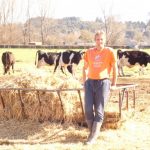
Jamie Forster may have received “exceptionally good” farm gate milk prices over the last three years, but he is still giving up dairy farming.
“It’s just the wear and tear. It’s seven days a week, and it’s quite stressful,” he said.
“And you’re dealing with the environment, which you can’t control.”
He is not alone.
Around the turn of the century there were 7,409 Victorian dairy businesses. There are now 2,796.
Last year in Victoria, Australia’s biggest milk producing state, 8 per cent of its dairy farmers quit the business.
“I’ve just been doing it for 37 years. My body and my mind has had enough,” Mr Forster said.
He said none of his four children wanted to take on the dairy farm at Cohuna in north-east Victoria.
Across the nation, milk production has shrunk to its lowest level in 30 years.
This season milk’s production is tipped to be nearly 3 billion litres less than the industry’s peak of 11.2 billion litres in the early 2000s.
Conversely, dairy imports like butter and cheese have nearly tripled to 27 per cent over the past 22 years and are rising, according to Dairy Australia.
Millennium drought starts dairy exodus
Mr Forster took over his parents’ farm in 2001.
The 12-year millennium drought hit soon after, which he described as “pretty tough”.
“We had to work out which bills we were going to pay, especially just starting out as a young fella,” Mr Forster said.
He draws irrigation water from the Murray River and drought conditions often mean low or no water allocations to those with permanent water licences.
With the federal government reviving water buybacks under the Murray-Darling Basin Plan, Mr Forster is worried about the next dry spell.
“When the next drought comes, there’ll be a lot of farmers leave the industry,” he said.
“A lot of older ones are just hanging in there.”
Mr Forster said the decline in dairy farming had “definitely taken its toll” on his community, with fewer people working in the industry.
“Our local tennis club have been going for over 100 years, but it finally finished up last year … couldn’t keep going,” he said.
Dairy crisis sparks change
In Victoria’s south-west, United Dairy Farmers of Victoria president Bernie Free was also concerned about the industry’s decline.
He said many dairy farmers were still recovering financially from the 2016 crisis when big milk processors retrospectively slashed the farm gate milk price and clawed back money already paid.
A mandatory code of conduct for milk processors now required them to offer a minimum price to farmers for the duration of their milk contracts.
Mr Free said farmers were still wary and it was becoming hard to attract the next generation to the industry.
“The young people aren’t as keen to come into an industry that’s not guaranteed on price,” he said.
“Costs have skyrocketed, land prices have doubled in some areas, so the return on the effort and the investment is just not there.”
The Australian Dairy Products Federation, which represents processors, has warned farmers should prepare for a price cut next season because Australia’s milk price is 30 per cent higher than global competitors.
But Mr Free said a decent milk price was essential to drive profitability and on-farm investment, which was key to growing milk production.
He said farmers were going to produce less milk if the price dropped.
“If we don’t have dairy farms that are profitable, and making a return on the investment, you won’t have people investing in the industry,” Mr Free said.
A ‘significant period of transformation’
Dairy analyst Michael Harvey said farm labour problems, the rising cost of farmland, floods, drought and other international factors, were creating an uncertain future for the industry.
“We’re seeing the Australian dairy industry go through a significant period of transformation,” he said.
Mr Harvey said a stable milk pool was essential for the manufacturing sector, and numerous expensive factories in Victoria were capable of processing much larger milk volumes to compete with imports.
But 10 Australian dairy factories have closed in the past 18 months and last month the Lactalis factory at Echuca in the state’s north announced it would also shut.
“That can have a huge impact on communities because these dairy companies in those communities are big employers,” Mr Harvey said.
Young dairy farmer invests big
However, some dairy farmers still say there is a profit to be made.
In Victoria’s south-east, Leongatha South farmer Callum Moscript has nearly finished a $5 million milking and calving shed to update his 60-year-old facility currently in use.
“It allows us to scale and grow and expand our business,” he said.
“I think there’s a huge future for dairy in South Gippsland and Victoria.”
As well as new sheds, in the past five years the Moscript family has bought more land and nearly doubled their herd to 550 cows.
While costs were nearly double the original estimate, Mr Moscript said the new dairy meant they could triple the number of cows milked an hour with “a third of the labour”, and better monitor cow health and production.
“The yard can hold 1,000 cows,” he said.
“People think I’m crazy for putting a yard in that big, but watch me.”
He hoped the farm gate milk price remained at a level to make it all work.
“We don’t know how we are going to pay for it, but we just believe in dairy,” Mr Moscript said.
You can now read the most important #news on #eDairyNews #Whatsapp channels!!!
🇺🇸 eDairy News INGLÊS: https://whatsapp.com/channel/0029VaKsjzGDTkJyIN6hcP1K
























